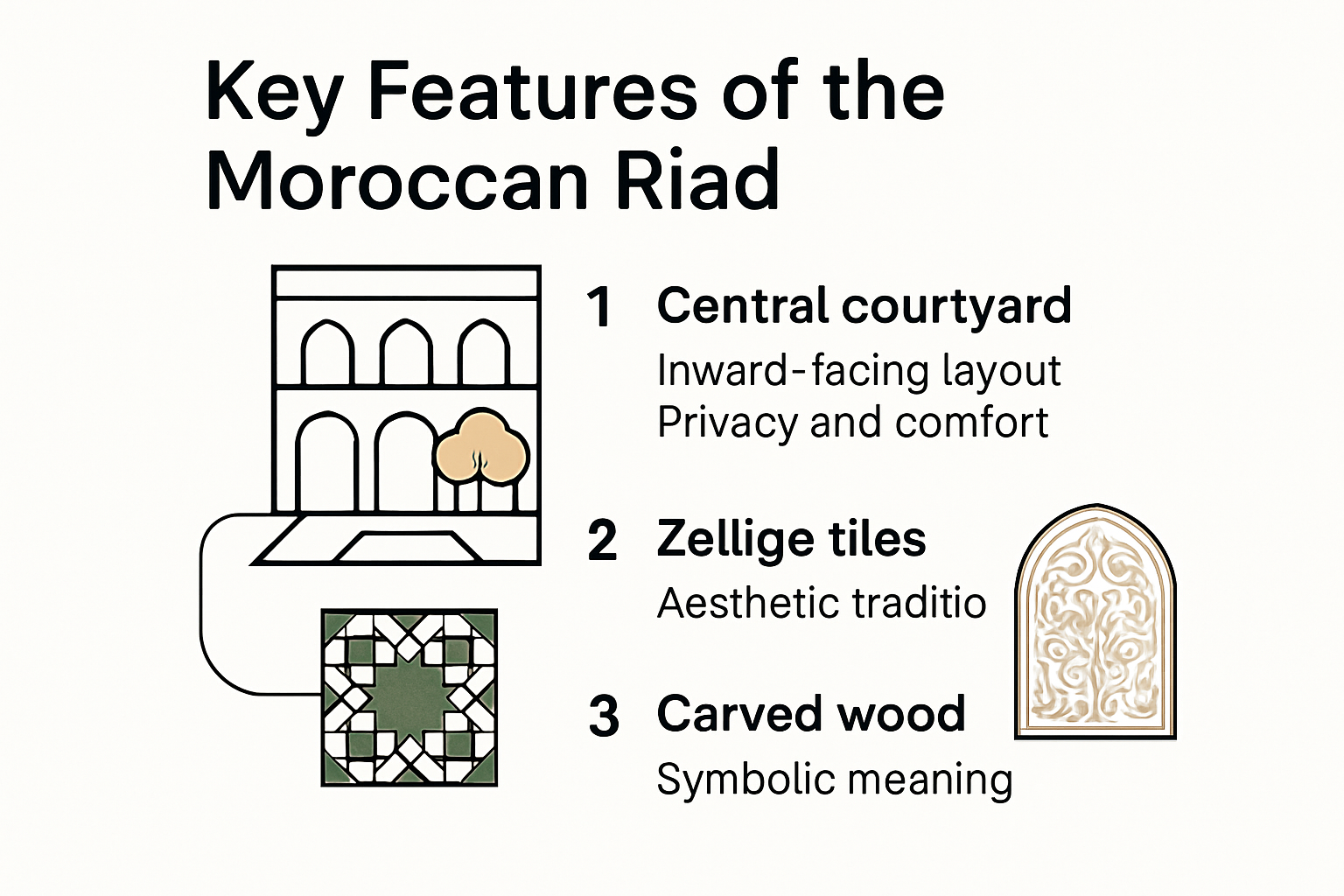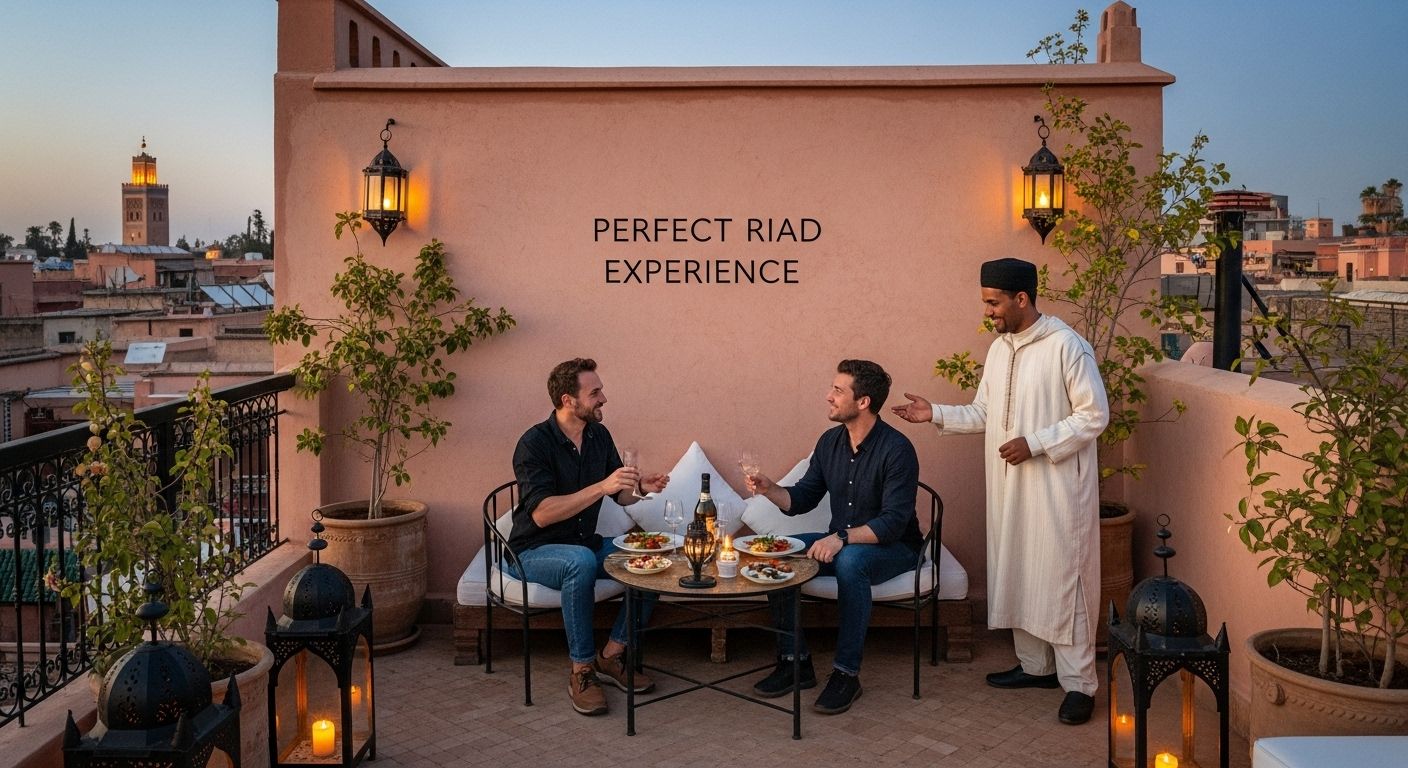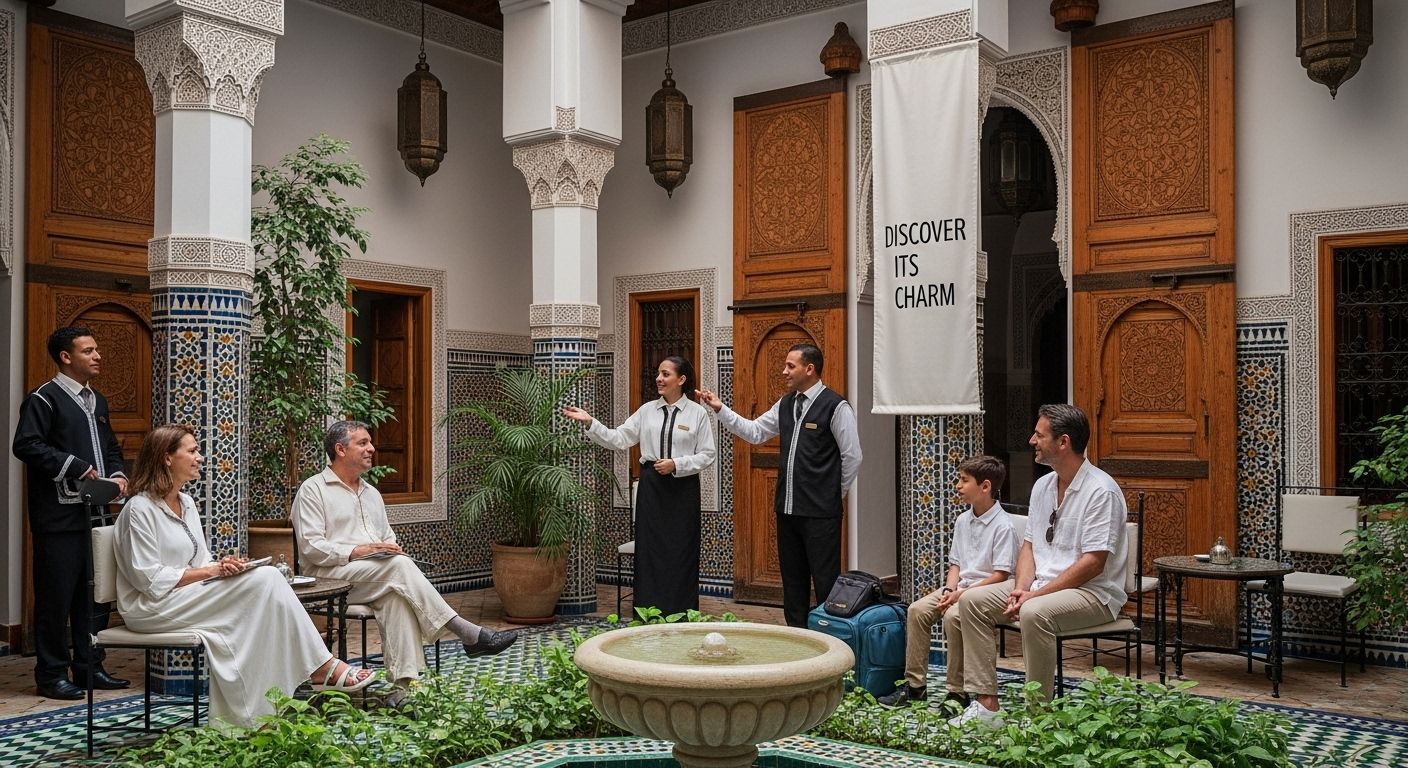Wondering what makes a Moroccan riad so enchanting? These centuries-old homes have preserved a secret world behind plain walls. But the biggest surprise is that over 80 percent of riads boast intricate central courtyards designed for absolute privacy and comfort, making them more than just architectural wonders. Instead of just being historic buildings, riads offer the kind of immersive, story-filled stay you simply cannot find in a modern hotel.
Table of Contents
- Understanding What Is A Riad And Its Origins
- Key Features That Make Riads Special
- Who Should Stay In A Riad And Why
- Tips For Booking The Perfect Riad Experience
Quick Summary
| Takeaway | Explanation |
|---|---|
| Riads embody Moroccan cultural heritage. | These traditional houses reflect historical values, privacy, and social structure in Moroccan society. |
| Inward design enhances privacy and comfort. | Riads feature elaborate interiors centered around a courtyard, shielding living areas from external view and creating a tranquil atmosphere. |
| Ideal for cultural and romantic travelers. | Riads offer personalized experiences, intimate settings, and direct connections to Moroccan culture, making them perfect for unique stays. |
| Book in advance for best options. | Planning reservations early, particularly during peak seasons, can secure your preferred riad and manage costs effectively. |
| Seek authenticity in your riad choice. | Opt for family-run establishments that prioritize traditional architectural elements and offer personalized hospitality for an immersive experience. |
Understanding What Is a Riad and Its Origins
A riad represents far more than a simple architectural design it is a profound expression of Moroccan cultural heritage and social living. Originating from the Arabic word “ryad” meaning “garden,” these traditional Moroccan houses offer a unique glimpse into the intricate social and architectural traditions of North African urban environments.
The Historical Roots of Riads
The architectural concept of a riad traces its origins to ancient Islamic and Andalusian-Moorish traditions, reflecting deep cultural principles of privacy and social hierarchy. Research from Archnet reveals that these structures evolved from ancient Persian garden-houses, developing a distinctive architectural style that prioritizes internal living spaces over external appearances.
Traditional riads are characterized by their inward-facing design, where elaborate interiors are hidden behind modest exterior walls. This architectural approach serves multiple purposes: protecting family privacy, creating a microclimate through central courtyards, and symbolizing social status through intricate decorative elements. The central courtyard, typically featuring a fountain or garden, acts as the heart of the home, providing natural light, ventilation, and a serene personal sanctuary.
Architectural and Cultural Significance
Scholarly research published in JSTOR highlights how riads were integral to the urban fabric of historic Moroccan cities like Fez and Marrakesh. These structures were not merely residences but complex social environments that reflected familial relationships, economic status, and cultural values.
The architectural design of a riad is meticulously planned to maximize comfort and privacy. Thick walls provide insulation against external heat, while the central courtyard creates a natural cooling system. Elaborate zellige tilework, carved wooden screens, and intricate plasterwork adorn interior spaces, demonstrating the extraordinary craftsmanship of Moroccan artisans. Each decorative element tells a story of cultural heritage, with geometric patterns and Islamic artistic traditions beautifully integrated into the home’s design.
Today, many traditional riads have been transformed into boutique hotels and guesthouses, allowing travelers to experience authentic Moroccan living spaces. These restored buildings offer visitors an immersive journey into Morocco’s rich architectural and cultural landscape, preserving a centuries-old tradition of elegant, private living that continues to captivate and inspire.
The table below summarizes the typical architectural features and cultural benefits of traditional Moroccan riads discussed in this section:
| Architectural Feature | Description & Benefit |
|---|---|
| Inward-facing design | Maximizes privacy; shelters courtyard from street views |
| Central courtyard | Provides natural light, ventilation & personal sanctuary; often includes fountain or garden |
| Thick exterior walls | Insulate against heat and noise |
| Zellige tilework & plasterwork | Showcases Moroccan craftsmanship and artistic tradition |
| Symmetrical interiors | Reflect Islamic garden-house heritage; facilitate comfort and social gathering |
| Modest exterior, ornate interior | Symbolizes focus on inner life over outward display; emphasizes family and cultural values |
Key Features That Make Riads Special
Riads represent a stunning architectural marvel that goes far beyond traditional housing design, embodying a unique blend of cultural sophistication and functional elegance. According to Mansion Global, these extraordinary structures are distinguished by intricate craftsmanship and deliberate architectural principles that transform living spaces into artistic experiences.
Architectural Elegance and Privacy
The most distinctive feature of a riad is its ingenious inward-facing design. Unlike conventional homes, riads turn their architectural beauty inward, creating a private sanctuary hidden from external view. High exterior walls conceal elaborate interiors, with rooms meticulously arranged around a central courtyard. Research from Arab America reveals that this design serves multiple purposes: providing thermal regulation, ensuring family privacy, and creating a serene microclimate.
The central courtyard acts as the heart of the riad, typically featuring a fountain and lush greenery. This space is not merely decorative but functional, offering natural light, ventilation, and a tranquil gathering area. Intricate zellige tilework, carved cedarwood elements, and tadelakt plasterwork adorn the interior, showcasing the extraordinary skill of Moroccan artisans.

Artistic and Cultural Symbolism
Each riad tells a profound story through its architectural elements. The Culture Trip highlights that interior walls often feature mesmerizing decorative elements including Quranic calligraphy, geometric patterns, and floral imagery. These are not mere decorations but complex cultural narratives embedded in architectural form.
Traditionally, the garden within a riad is symmetrically divided, often featuring citrus trees like oranges and lemons, along with fragrant plants such as jasmine and roses. The fountain at the center represents more than aesthetic beauty it symbolizes life, purification, and hospitality in Islamic architectural traditions. Hand-crafted details created by local artisans woodworkers, plasterers, and tile-cutters transform each riad into a unique masterpiece.
Today, many riads have been beautifully restored and transformed into exceptional accommodations, allowing travelers to experience this extraordinary architectural heritage. These living museums offer guests an immersive journey into Moroccan culture, where every architectural detail speaks of centuries of artistic tradition, social sophistication, and architectural innovation.
Who Should Stay in a Riad and Why
Riads offer a unique accommodation experience that goes far beyond traditional hotels, appealing to travelers seeking more than just a place to sleep. According to UNESCO World Heritage insights, these historic dwellings provide an unparalleled opportunity to immerse oneself in authentic Moroccan cultural heritage.
Cultural Enthusiasts and Heritage Travelers
Travelers passionate about cultural immersion will find riads to be extraordinary living museums. These architectural gems are perfect for those who want to experience Morocco beyond surface-level tourism. Wikipedia notes that riads offer a direct connection to traditional Moroccan living spaces, allowing guests to understand the intricate social and architectural traditions that have shaped Moroccan society for centuries.
Historical architecture buffs, photographers, and design lovers will be particularly captivated by the meticulous craftsmanship. Each riad tells a story through its zellige tiles, carved wooden details, and intricate plasterwork. The opportunity to stay in a space that represents centuries of architectural evolution is an experience unlike any standard hotel accommodation.
Romantic Travelers and Intimate Experience Seekers
Couples and travelers seeking intimate, personalized experiences will find riads to be exceptionally romantic settings. The private courtyards, secluded terraces, and limited number of rooms create an atmosphere of exclusivity and tranquility. Travelers interested in unique accommodations will appreciate how these spaces offer a stark contrast to impersonal, large-scale hotels.
Many riads provide personalized services that transform a simple stay into a memorable journey. From traditional Moroccan breakfast served in the courtyard to personalized guided tours arranged by local hosts, these accommodations offer a level of intimacy and connection that large hotels cannot match. The serene environment, often located in the heart of historic medinas, provides a peaceful retreat from the bustling streets outside.
Adventure Travelers and Cultural Explorers
Independent travelers, solo adventurers, and those seeking authentic local experiences will find riads to be the perfect base for exploration. Research from Fez’s architectural heritage highlights how these accommodations are strategically located in historic city centers, providing immediate access to local markets, historical sites, and cultural experiences.
Backpackers, digital nomads, and travelers who prioritize meaningful cultural interactions will appreciate the genuine hospitality typical of riad accommodations. Unlike large hotels, riads often feature owners or managers who are passionate about sharing local knowledge, offering insider tips about the neighborhood, recommending hidden gems, and providing a deeper understanding of Moroccan culture.
Whether you are a history buff, a romantic traveler, an adventure seeker, or simply someone looking to experience Morocco beyond conventional tourism, staying in a riad promises an unforgettable journey into the heart of Moroccan cultural and architectural tradition.
Below is a table summarizing the different types of travelers who benefit most from riad stays, along with the key experiences they can expect:
| Traveler Type | Riad Experience Highlights |
|---|---|
| Cultural Enthusiasts & Heritage Travelers | Living museum of Moroccan culture, authentic architecture, artisan details |
| Romantic Couples & Intimacy Seekers | Private courtyards, exclusive service, tranquil and romantic atmosphere |
| Adventure Travelers & Cultural Explorers | Central medina locations, local tips, easy access to markets and sites |
| Solo Travelers & Digital Nomads | Genuine hospitality, connection with hosts, meaningful cultural exchange |
| Architecture & Art Lovers | Unique design, history, craftsmanship on display in every space |
Tips for Booking the Perfect Riad Experience
Booking the ideal riad requires careful consideration and strategic planning to ensure an authentic and memorable Moroccan experience. Awakened Voyages emphasizes that selecting the right riad goes beyond simply finding a place to stay it is about curating a unique cultural journey.
Location and Accessibility Considerations
The location of your riad can dramatically impact your travel experience. Many riads are nestled within the intricate maze-like streets of historic medinas, which can be challenging to navigate. Travel Answers Group recommends confirming transportation logistics in advance. Consider riads that offer airport transfers or can arrange for a local guide to meet you at a recognizable landmark.
Mobility is another crucial factor. Traditional riads often feature narrow staircases and rooms with multiple levels, which might pose challenges for travelers with limited mobility. When booking, ask specific questions about room accessibility, elevator availability, and room locations within the property. Some riads have ground-floor rooms or more accessible options that can accommodate different physical needs.
Booking Strategies and Seasonal Planning
Travibis Travel Insights provides valuable guidance on strategic booking. The timing of your reservation can significantly impact both availability and pricing. For peak season (December to March), book 2-3 months in advance. During shoulder seasons (April-May and October-November), a 1-2 month advance booking works well. Summer months (June-September) typically require 2-4 weeks of advance planning.
Financial considerations are equally important. Be prepared for potential additional fees such as tourist taxes (approximately 2-5 EUR per person per night) and deposit requirements. Many riads request a 50% deposit at the time of booking. Carefully review cancellation policies and consider travel insurance for added protection. Explore unique accommodations that offer flexible booking options and transparent pricing.
This table summarizes the recommended booking timing and key financial considerations for planning a riad stay:
| Season | Recommended Booking Lead Time | Typical Extra Costs | Deposit Required |
|---|---|---|---|
| Peak (Dec–Mar) | 2–3 months | Tourist taxes (2-5 EUR/pp/night) | Often 50% at booking |
| Shoulder (Apr–May, Oct–Nov) | 1–2 months | Potential deposits; variable by property | Usually, partial |
| Summer (Jun–Sep) | 2–4 weeks | May have seasonal offers; fewer surcharges | Sometimes flexible |
Authenticity and Personal Experience
Choosing a riad is about more than amenities it is about experiencing genuine Moroccan hospitality. Look for family-run establishments that offer personalized services and local insights. Read reviews that highlight interactions with owners and staff, not just room quality. Some riads offer additional experiences like cooking classes, guided medina tours, or traditional music performances that can enrich your stay.
Consider the architectural and historical authenticity of the riad. Seek properties that have preserved original features like zellige tilework, carved wooden details, and traditional courtyard designs. Owners who are passionate about maintaining the cultural integrity of their property often provide the most immersive experiences.
Remember that each riad tells a unique story. By carefully selecting your accommodation, you are not just booking a room but investing in a memorable cultural journey that connects you deeply with Morocco’s rich architectural and social heritage.

Frequently Asked Questions
What is a riad?
A riad is a traditional Moroccan house or palace characterized by its inward-facing design, focusing on a central courtyard that provides privacy and comfort. They often reflect the architectural heritage and cultural values of Moroccan society.
What are the key features that make riads special?
Riads are known for their unique architectural elegance, which includes a central courtyard, intricate tilework, thick walls for insulation, and ornate interiors that tell a story of Moroccan craftsmanship and cultural significance.
Who should consider staying in a riad?
Riads are ideal for cultural enthusiasts, romantic travelers, and adventure seekers looking for a unique and immersive experience in Moroccan culture. They provide personalized experiences and an intimate atmosphere that large hotels often lack.
How can I choose the right riad for my stay?
To choose the right riad, consider factors like location within the medina, accessibility features, review the authenticity of the architectural elements, and look for family-run establishments that offer personalized services and local insights.
Ready to Experience the True Magic of a Riad?
Understanding the unique charm of a Moroccan riad, you know the value of authentic privacy, artistic heritage, and immersive cultural experiences. Yet, finding the perfect riad and making genuine local discoveries on your own can be overwhelming. Many travelers struggle with questions about location, accessibility, or getting personalized recommendations that turn an ordinary stay into something extraordinary.
With TopMoroccoTravel.com, you unlock more than handpicked riad stays. You gain access to expert travel planning, tailored tours, and insider knowledge that ensure your experience is as special as the riads themselves. If you are eager to combine the comfort of a private riad with guided city tours or cultural immersions, start by browsing our unique accommodation guide and let our team design your perfect Moroccan journey. Visit TopMoroccoTravel.com now to reserve your unforgettable riad escape before popular dates fill up.
Recommended
- Where to Stay Morocco: Top Hotels and Riads Guide
- Marrakech Travel Guide 2025: Explore Morocco’s Vibrant Heart – Top Morocco Travel
- Exploring Marrakech Medina Morocco: Guide for All Travelers
- Morocco Luxury Tours: Experience the Best of Morocco in Style – Top Morocco Travel






Comments are closed